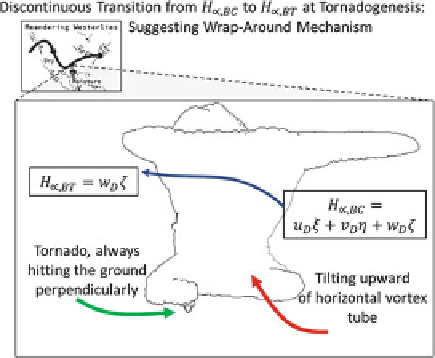Geoscience Reference
In-Depth Information
Fig. 18.3 Discontinous
transition from supercell
storm or mesocyclone to
tornado.
It is schematically
shown by the transition of
H
ˇ
)
H
˛;
BC
C
Wrap-around
mechanism
H
˛;
BT
.The
divergent velocity
v
D
or
v
˛
has Cartesian components,
u
D
,v
D
,andw
D
)
H
˛
) H
˛;
BT
WD w
D
;
(18.24)
where the subscript BT satands for barotropic.
The notations of H
˛;
BC
and H
˛;
BT
are used because the former of (
18.23
)
represents the cases where entropic source and sink are of larger magnitudes and
the latter of (
18.24
) does smaller magnitudes. It is valid for the stretching process
of tornado and is consistent with the boundary condition of vanishing vertical
velocity at the ground surface. The helicity grows up to its maximum near the
mature stage of a tornado when the updraft w is intensified due to convective
buoyancy, and the vorticity
by upward stretching. At and after the mature stage,
the updraft changes to a low-magnitude updraft or to a downdraft due to the
development of a negative vertical pressure gradient, and the helicity decreases
suddenly as demonstrated by
Noda
(
2002
)and
Noda and Niino
(
2005
,
2010
)in
numerical simulations of tornadoes. The above discussion suggests that the helicity
calculated by the entropic balance theory will vary between H
ˇ;
BC
at the supercell
mesocyclone, Lear Frank Downdraft (RFD), hook echo stages, and H
˛;
BT
at the
mature tornadic stage. Figure
18.3
is prepared to show schematically the roles of
H
˛;
BC
and H
˛;
BT
suggesting sufficient requirement of wrap- around mechanism for
tornadogenesis allowing downdraft core of tornado surrounded updraft tornado with
high helicity, barotropic surrounding as demonstrated in Fig.
18.4
.
The conventional helicity is an index used in tornado research, and, as discussed
in the introduction, used to determine how small the term r
.
is and when
the vorticity becomes stationary, as seen from (
18.9
)to(
18.12
). Because of (
18.10
),
the helicity (v
!/
v
!/
is used as an index, although it is indirect. However, the vorticity
(
18.9
) lacks the solenoidal term, which is important. Instead of (
18.9
), the more
accurate vorticity equation is
@
t
!
Dr
.
v
!/
r
..1=/
rp
/;
(18.25)

Search WWH ::

Custom Search